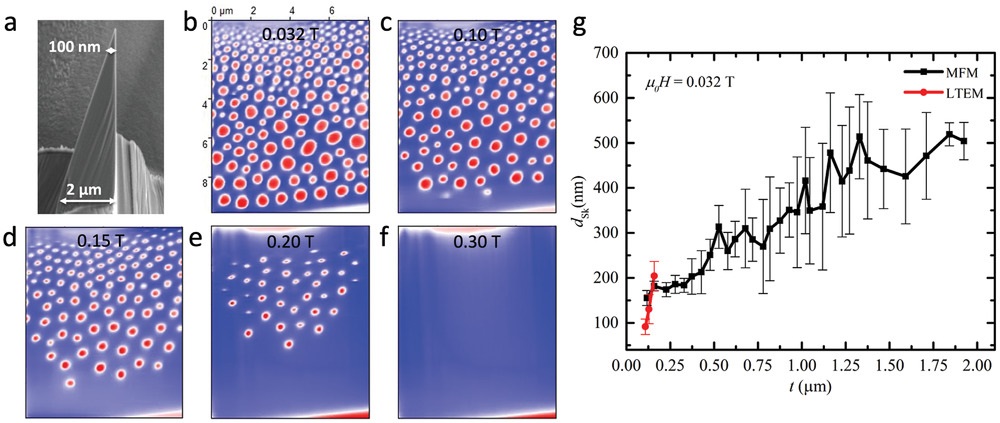There is considerable interest in van der Waals (vdW) materials as potential hosts for chiral skyrmionic spin textures. Of particular interest is the ferromagnetic, metallic compound Fe3GeTe2 (FGT), which has a comparatively high Curie temperature (150–220 K). Several recent studies have reported the observation of chiral Néel skyrmions in this compound, which is inconsistent with its presumed centrosymmetric structure.*
In the article “Magnetic Skyrmions in a Thickness Tunable 2D Ferromagnet from a Defect Driven Dzyaloshinskii–Moriya Interaction” Anirban Chakraborty, Abhay K. Srivastava, Ankit K. Sharma, Ajesh K. Gopi, Katayoon Mohseni, Arthur Ernst, Hakan Deniz, Binoy Krishna Hazra, Souvik Das, Paolo Sessi, Ilya Kostanovskiy, Tianping Ma, Holger L. Meyerheim and Stuart S. P. Parkin report the observation of Néel type skyrmions in single crystals of FGT via Lorentz transmission electron microscopy (LTEM).*
Since LTEM requires transmission of electrons through the sample thickness, the authors investigated the thicker lamella L2 using only magnetic force microscopy (MFM). *
For MFM measurements, the lamella was transferred on a prepatterned silicon substrate to be easily accessible by MFM tip. The measurements were performed in a vacuum and NANOSENSORS™ SuperSharpSilicon™ AFM probes for magnetic force microscopy (SSS-MFMR) were used for all measurements. *
In the article it is shown from detailed X-ray diffraction structure analysis that FGT lacks an inversion symmetry as a result of an asymmetric distribution of Fe vacancies. This vacancy-induced breaking of the inversion symmetry of this compound is a surprising and novel observation and is a prerequisite for a Dzyaloshinskii–Moriya vector exchange interaction which accounts for the chiral Néel skyrmion phase. This phenomenon is likely to be common to many 2D vdW materials and suggests a path to the preparation of many such acentric compounds. *
Furthermore, it is found that the skyrmion size in FGT is strongly dependent on its thickness: the skyrmion size increases from ≈100 to ≈750 nm as the thickness of the lamella is increased from ≈90 nm to ≈2 µm. This extreme size tunability is a feature common to many low symmetry ferro- and ferri-magnetic compounds. *

Figure 4 from “Magnetic Skyrmions in a Thickness Tunable 2D Ferromagnet from a Defect Driven Dzyaloshinskii–Moriya Interaction” by Anirban Chakraborty et al.
Thickness dependence of skyrmion size in lamella L2 as imaged by MFM. a) SEM image of the wedge-shaped lamella. The thickness of the lamella varies from ≈100 nm to ≈2 µm. b) MFM image of skyrmions in the lamella at 100 K and 0.032 T. c–f) Evolution of skyrmions as the field is increased from 0.1 to 0.2 T and finally reaches the field polarized state at ≈0.3 T. The blue and red contrast in the MFM images represent up- and down-magnetized domains. All MFM images are at the same scale: a scale bar is shown in (b). g) Skyrmion diameter as a function of lamella thickness including both MFM and LTEM data.
*Anirban Chakraborty, Abhay K. Srivastava, Ankit K. Sharma, Ajesh K. Gopi, Katayoon Mohseni, Arthur Ernst, Hakan Deniz, Binoy Krishna Hazra, Souvik Das, Paolo Sessi, Ilya Kostanovskiy, Tianping Ma, Holger L. Meyerheim and Stuart S. P. Parkin
Magnetic Skyrmions in a Thickness Tunable 2D Ferromagnet from a Defect Driven Dzyaloshinskii–Moriya Interaction
Advanced Materials, Volume 34, Issue 11, March 17, 2022, 2108637
DOI: https://doi.org/10.1002/adma.202108637
Open Access: The article “Magnetic Skyrmions in a Thickness Tunable 2D Ferromagnet from a Defect Driven Dzyaloshinskii–Moriya Interaction” by Anirban Chakraborty, Abhay K. Srivastava, Ankit K. Sharma, Ajesh K. Gopi, Katayoon Mohseni, Arthur Ernst, Hakan Deniz, Binoy Krishna Hazra, Souvik Das, Paolo Sessi, Ilya Kostanovskiy, Tianping Ma, Holger L. Meyerheim and Stuart S. P. Parkin is licensed under a Creative Commons Attribution 4.0 International License, which permits use, sharing, adaptation, distribution and reproduction in any medium or format, as long as you give appropriate credit to the original author(s) and the source, provide a link to the Creative Commons license, and indicate if changes were made. The images or other third party material in this article are included in the article’s Creative Commons licence, unless indicated otherwise in a credit line to the material. If material is not included in the article’s Creative Commons licence and your intended use is not permitted by statutory regulation or exceeds the permitted use, you will need to obtain permission directly from the copyright holder. To view a copy of this licence, visit https://creativecommons.org/licenses/by/4.0/.